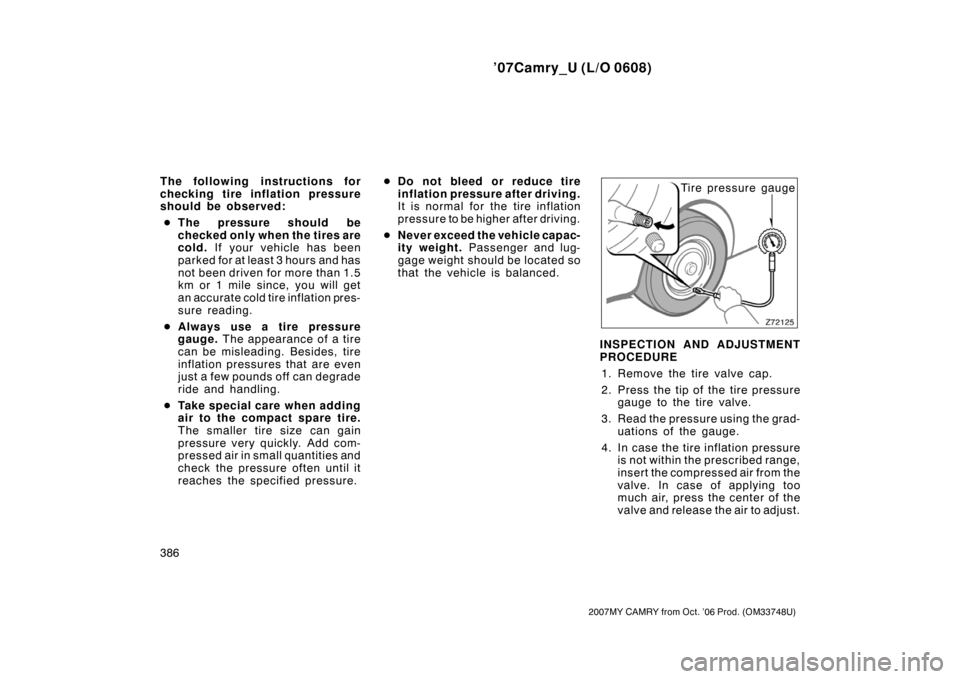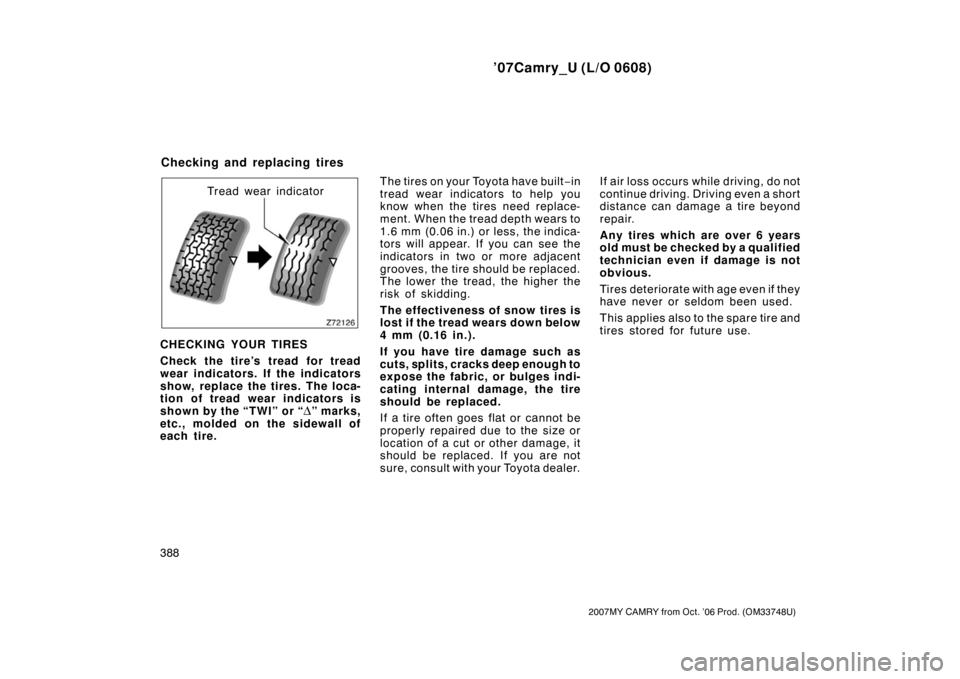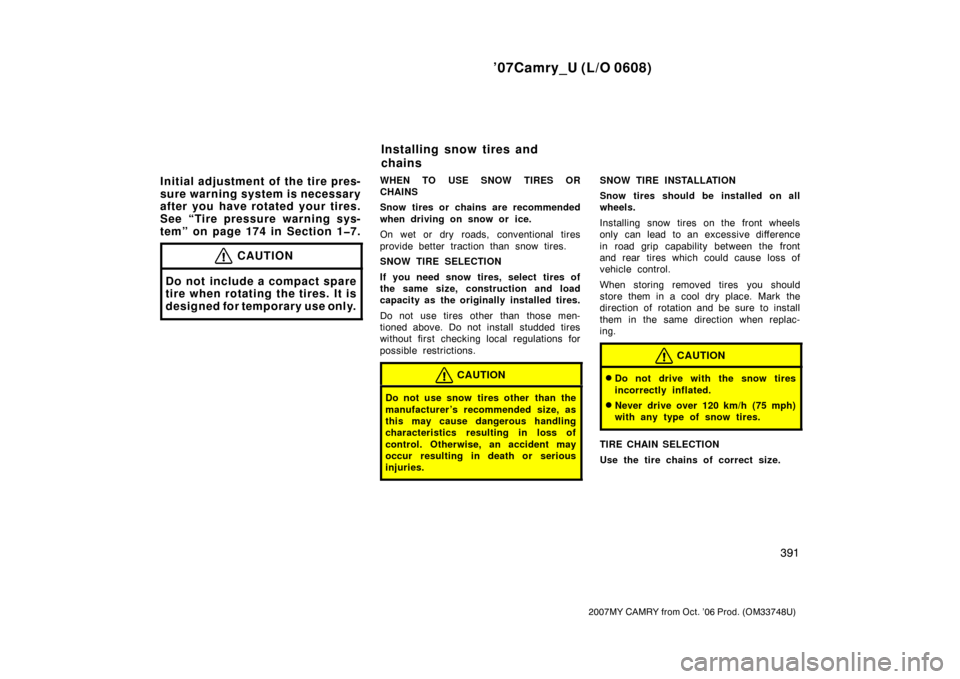Page 354 of 428
’07Camry_U (L/O 0608)
346
2007MY CAMRY from Oct. ’06 Prod. (OM33748U)
Before removing the jack, unhook the
tightening strap.
After storing the jack, make sure it is
securely held by the tightening strap.
This prevents the jack from flying for-
ward during a collision or sudden
stop.To remove the spare tire:
1. Loosen the nut and remove it.
2. Remove the spare tire cover.
3. Loosen the bolt and remove it.
4. Remove the spacer (with alumi-
num wheels).
Then take the spare tire out of the
vehicle.When storing the spare tire, put it in
place with the outer side of the wheel
facing up. Then secure the tire by re-
peating the above removal steps in
reverse order to prevent it from flying
forward during a collision or sudden
braking.
Page 357 of 428
’07Camry_U (L/O 0608)
349
2007MY CAMRY from Oct. ’06 Prod. (OM33748U)
6. After making sure that no one
is in the vehicle, raise it high
enough so that the spare tire
can be installed.
Remember you will need more ground
clearance when putting on the spare
tire than when removing the flat tire.
To raise the vehicle, insert the jack
handle into the jack (it is a loose fit)
and turn it clockwise. As the jack
touches the vehicle and begins to lift,
double−check that it is properly posi-
tioned.
CAUTION
Never get under the vehicle when
the vehicle is supported by the
jack alone.
7. Remove the wheel nuts and
change tires.
Lift the flat tire straight off and put it
aside.
Roll the spare wheel into position and
align the holes in the wheel with the
bolts. Then lift up the wheel and get
at least the top bolt started through
its hole. Wiggle the tire and press it
back over the other bolts.
—Raising your vehicle —Changing wheels
Page 360 of 428

’07Camry_U (L/O 0608)
352
2007MY CAMRY from Oct. ’06 Prod. (OM33748U)
CAUTION
Take due care in handling the or-
nament to avoid unexpected per-
sonal injury.
11. Check the air pressure of the re-
placed tire.
Adjust the air pressure to the specifi-
cation designed on page 411 in Sec-
tion 8. If the pressure is lower, drive
slowly to the nearest service station
and fill to the correct pressure.
Do not forget to reinstall the tire infla-
tion valve cap as dirt and moisture
could get into the valve core and
possibly cause air leakage. If the cap
is missing, have a new one put on as
soon as possible.
12.Restow all the tools, jack and
flat tire securely.
As soon after changing wheels as
possible, tighten the wheel nuts to the
torque specified on page 411 in Sec-
tion 8 with a torque wrench. Have a
technician repair the flat tire and re-
place the spare tire with it.Initial adjustment of the tire pres-
sure warning system is necessary
after you have replaced your tires
or wheels. See “Tire pressure
warning system” on page 174 in
Section 1�7.
CAUTION
Before driving, make sure all the
tools, jack and flat tire are se-
curely in place in their storage
location to reduce the possibility
of personal injury during a colli-
sion or sudden braking.
—After changing wheels
Page 393 of 428
’07Camry_U (L/O 0608)
385
2007MY CAMRY from Oct. ’06 Prod. (OM33748U)
Ty p e ATy p e B
Keep your tire inflation pressures
at the proper level.
The recommended cold tire inflation
pressures, tire sizes and the com-
bined weight of occupants and cargo
(vehicle capacity weight) are de-
scribed on page 406 and 411. They
are also on the tire and loading infor-
mation label.
You should check the tire inflation
pressure every two weeks, or at least
once a month. And do not forget the
spare!
Checking tire inflation
pressure
Page 394 of 428

’07Camry_U (L/O 0608)
386
2007MY CAMRY from Oct. ’06 Prod. (OM33748U)
The following instructions for
checking tire inflation pressure
should be observed:
�The pressure should be
checked only when the tires are
cold. If your vehicle has been
parked for at least 3 hours and has
not been driven for more than 1.5
km or 1 mile since, you will get
an accurate cold tire inflation pres-
sure reading.
�Always use a tire pressure
gauge. The appearance of a tire
can be misleading. Besides, tire
inflation pressures that are even
just a few pounds off can degrade
ride and handling.
�Take special care when adding
air to the compact spare tire.
The smaller tire size can gain
pressure very quickly. Add com-
pressed air in small quantities and
check the pressure often until it
reaches the specified pressure.�Do not bleed or reduce tire
inflation pressure after driving.
It is normal for the tire inflation
pressure to be higher after driving.
�Never exceed the vehicle capac-
ity weight. Passenger and lug-
gage weight should be located so
that the vehicle is balanced.Tire pressure gauge
INSPECTION AND ADJUSTMENT
PROCEDURE
1. Remove the tire valve cap.
2. Press the tip of the tire pressure
gauge to the tire valve.
3. Read the pressure using the grad-
uations of the gauge.
4. In case the tire inflation pressure
is not within the prescribed range,
insert the compressed air from the
valve. In case of applying too
much air, press the center of the
valve and release the air to adjust.
Page 396 of 428

’07Camry_U (L/O 0608)
388
2007MY CAMRY from Oct. ’06 Prod. (OM33748U)
Tread wear indicator
CHECKING YOUR TIRES
Check the tire’s tread for tread
wear indicators. If the indicators
show, replace the tires. The loca-
tion of tread wear indicators is
shown by the “TWI” or “
Δ” marks,
etc., molded on the sidewall of
each tire.The tires on your Toyota have built−in
tread wear indicators to help you
know when the tires need replace-
ment. When the tread depth wears to
1.6 mm (0.06 in.) or less, the indica-
tors will appear. If you can see the
indicators in two or more adjacent
grooves, the tire should be replaced.
The lower the tread, the higher the
risk of skidding.
The effectiveness of snow tires is
lost if the tread wears down below
4 mm (0.16 in.).
If you have tire damage such as
cuts, splits, cracks deep enough to
expose the fabric, or bulges indi-
cating internal damage, the tire
should be replaced.
If a tire often goes flat or cannot be
properly repaired due to the size or
location of a cut or other damage, it
should be replaced. If you are not
sure, consult with your Toyota dealer.If air loss occurs while driving, do not
continue driving. Driving even a short
distance can damage a tire beyond
repair.
An y ti res wh i ch are over 6 years
old must be checked by a qualified
technician even if damage is not
obvious.
Tires deteriorate with age even if they
have never or seldom been used.
This applies also to the spare tire and
tires stored for future use.
Checking and replacing tires
Page 398 of 428
’07Camry_U (L/O 0608)
390
2007MY CAMRY from Oct. ’06 Prod. (OM33748U)
With a spare tire of the same
wheel type as the installed tiresWith a spare tire of different
wheel type from the installed
tiresTo equalize the wear and help ex-
tend tire life, Toyota recommends
that you rotate your tires accord-
ing to the maintenance schedule.
(For scheduled maintenance infor-
mation, please refer to the “Sched-
uled Maintenance Guide” or “Own-
er’s Manual Supplement”.)
However, the most appropriate tim-
ing for tire rotation may vary ac-
cording to your driving habits and
road surface conditions.
See “If you have a flat tire” on page
343 in Section 4 for tire change proce-
dure.
When rotating tires, check for uneven
wear and damage. Abnormal wear is
usually caused by incorrect tire pres-
sure, improper wheel alignment, out−
of−balance wheels, or severe braking.
Rotating tires
Page 399 of 428

’07Camry_U (L/O 0608)
391
2007MY CAMRY from Oct. ’06 Prod. (OM33748U)
Initial adjustment of the tire pres-
sure warning system is necessary
after you have rotated your tires.
See “Tire pressure warning sys-
tem” on page 174 in Section 1�7.
CAUTION
Do not include a compact spare
tire when rotating the tires. It is
designed for temporary use only.
WHEN TO USE SNOW TIRES OR
CHAINS
Snow tires or chains are recommended
when driving on snow or ice.
On wet or dry roads, conventional tires
provide better traction than snow tires.
SNOW TIRE SELECTION
If you need snow tires, select tires of
the same size, construction and load
capacity as the originally installed tires.
Do not use tires other than those men-
tioned above. Do not install studded tires
without first checking local regulations for
possible restrictions.
CAUTION
Do not use snow tires other than the
manufacturer ’s recommended size, as
this may cause dangerous handling
characteristics resulting in loss of
control. Otherwise, an accident may
occur resulting in death or serious
injuries.
SNOW TIRE INSTALLATION
Snow tires should be installed on all
wheels.
Installing snow tires on the front wheels
only can lead to an excessive difference
in road grip capability between the front
and rear tires which could cause loss of
vehicle control.
When storing removed tires you should
store them in a cool dry place. Mark the
direction of rotation and be sure to install
them in the same direction when replac-
ing.
CAUTION
�Do not drive with the snow tires
incorrectly inflated.
�Never drive over 120 km/h (75 mph)
with any type of snow tires.
TIRE CHAIN SELECTION
Use the tire chains of correct size.
Installing snow tires and
chains